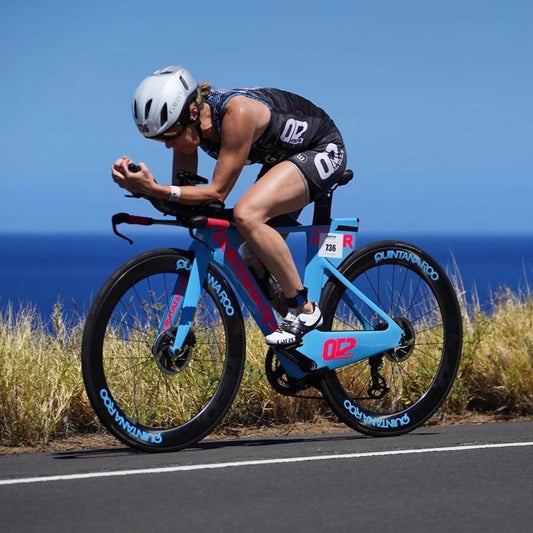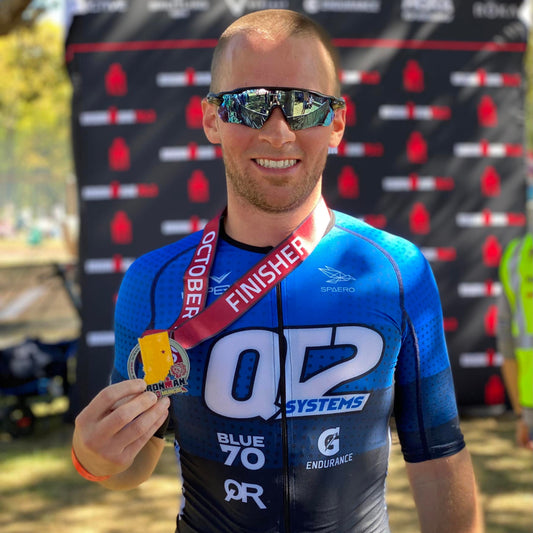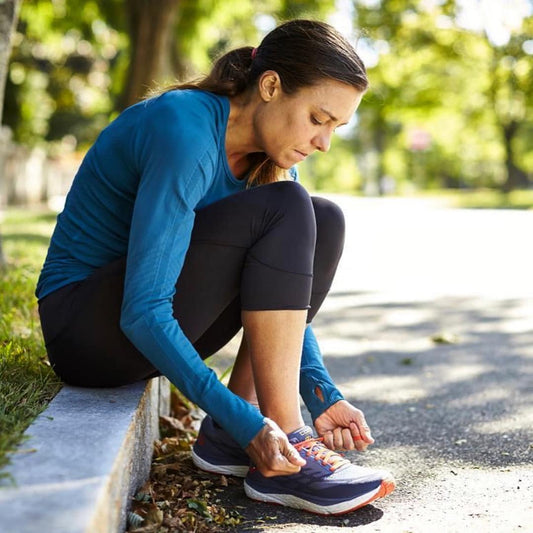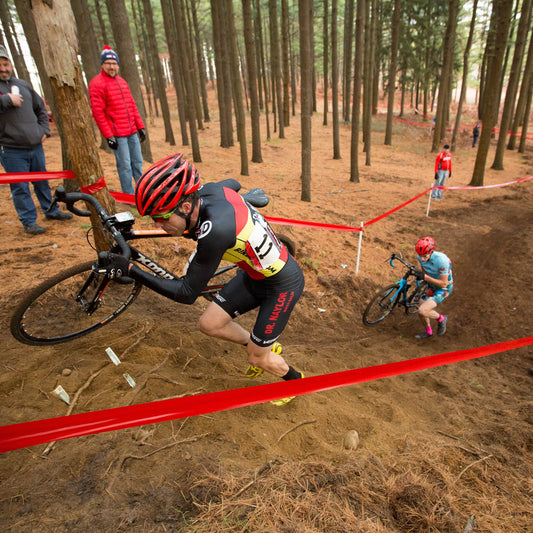Let’s face it - for triathletes, any injury is a figurative pain in the behind! Some, though, are quite literally so-and high hamstring tendinopathy is one of them. Although not as prevalent as some more common tendinopathies in the leg (as in, the Achilles tendon, or patellar tendon in the knee), high hamstring tendinopathies are notoriously stubborn, and frustrating to athletes and treating practitioners alike-something I can personally attest to (more than I’d care to admit), having been on both sides of that equation as a triathlete and physical therapist. So, what exactly is high hamstring tendinopathy? What leads to this issue? What can we do about it?
Anatomy/function
The hamstrings consist of three muscles that run down the back of the thigh, before diverging and attaching below the knee-the semimembranosus, semitendinosus, and biceps femoris. Higher up, the muscles attach to the pelvis at the ischial tuberosity, more commonly known as the “sit bones” of the pelvis. Running close to the tendon is the sciatic nerve, which can complicate matters. Together, the hamstrings cross two joints, and act to bend the knee, and help the gluteals extend the hip. So, what does that mean for how we use them for triathlon-specific activities? During running, the hamstring works in several different ways during the gait cycle. During stance phase, which is considered the time from which a foot hits the ground through to when toe off occurs, the hamstrings help the glutes counteract gravity early on (which is where they’re loaded the most during stance), and later assist them with pushing off into hip extension. They then bend the knee as the leg moves into swing phase (when the foot is off of the ground). The highest peak force occurs in late swing phase. As the leg swings forward, the hamstring works to stop the knee from extending too far forward, prior to starting to extend the hip before the foot even hits the ground again.

Hamstring muscle anatomy.
Source: https://www.orthobullets.com/knee-and-sports/3102/hamstring-injuries

Visual of run gait phases, with reference to the right leg.
Source: https://andrewsacksperformance.com/2013/05/11/hamstring-training-for-sprinting-speed/
What about during biking? Hamstrings don’t play as large of a role as they do while running, but they are involved to some degree. At the bottom of the pedal stroke, the hamstrings, along with the calves, help to pull the foot back up, although the opposite leg’s downstroke tends to be the more powerful contributor to this motion. During the downstroke, the hamstrings assist the quadriceps and gluteals in producing power as the hip and knee extend, especially towards the bottom of the pedal stroke.
Symptoms/diagnosis/pathology
Like with most overuse injuries, high hamstring tendinopathy tends to come on gradually. Pain occurs deep in the buttock area, can radiate down the back of the thigh, and is often described as a tightness or cramping feeling. Running, leaning forward, and prolonged sitting all can increase symptoms. In the earlier stages, pain tends to decrease after a warm up period and then returns after activity; as the condition progresses, pain persists throughout activity, and permeates throughout daily life. Because of its proximity to the tendon, sciatic nerve irritation may also be present, and pain may radiate further down the leg. Tenderness over the sit bone is common, and several clinical tests that involve placing the hamstring in stretched positions or activating it against resistance at different angles can implicate the tendon as the source of pain. Gluteal muscle strains, adductor tendon issues, pelvic stress fractures, certain hip and pelvic impingement conditions, arthritis, bursitis, and lower back issues (particularly involving the sciatic nerve) can present similarly to high hamstring tendinopathy, so these tests can help differentiate between the conditions. MRIs may show tendon thickening, increased signal around the tendon, and edema within the bone at the tendon’s attachment.

For those who are into this type of thing-MRI image of my own high hamstring tendinopathy/possible partial tearing in early 2019 (imagine this as a cross-section looking down on the body). The white strip is some reactive edema in the bone, and the rest is what my doctor referred to as ”this junk”-aka, the tendon not looking like it should.
The pathology of high hamstring tendinopathy has become better understood in recent years. Tendons are pretty darn good at withstanding tensile (pulling) forces, but not so great when they’re compressed. This happens to the hamstring attachment when it gets wrapped around the ischial tuberosity in flexed positions-think of a cable being wrapped around a pulley. Early on, the tendinopathy may be more reactive or inflammatory, but more chronic tendon conditions progress into tendon disrepair and degeneration. Collagen, which is the building block of tendons, breaks down and loses its normal neat architecture. Additionally, changes occur to pain sensitization, and the body tries to compensate.

Depiction of collagen disorganization caused by tendinopathies.
Source: https://chiroup.com/tendinopathy/
What, then, causes high hamstring injuries?
As just stated, high hamstring tendons are not a fan of compressive forces, which occur when the hip is flexed. So, that’s why that late swing phase of the run gait referenced above, where the hamstring goes through a stretch/shortening cycle while the hip is the most flexed that it gets while running, is thought to be where the point of greatest vulnerability. Certain run training and gait factors are thought to increase this risk. As with any running injury, history of previous injury, and increasing volume or intensity too quickly tend to be strong predictors of future injury-no surprises there. High hamstring tendons are especially vulnerable to increases in speed work, hill running, or exercises such as lunges and squats, which tend to put the hip into greater degrees of flexion while increasing hamstring force. In terms of run gait, overstriding, which increases the overall pull on the hamstring, increases risk. A forward trunk lean and decreased hip extension with running also is often seen, although it can be debated if these are causes or compensatory effects of high hamstring tendinopathy.
Cycling can also contribute to high hamstring tendinopathy. In the quest for saddle comfort, it’s often considered preferable to get us sitting on our sit bones...or, right on our hamstring attachments, presenting a conundrum. Certainly, sitting on a wide, cushy couch-like seat isn’t going to be the best for power transfer, but seats that are the wrong width (usually too narrow), or too hard can do a number on hamstring attachments. As anyone who’s ever tried to get into a relatively aggressive position knows, decreased hamstring flexibility can be a limiter. It follows that riding in the aerobars in high degrees of hip flexion without adequate hamstring length will put quite a bit of stress on that attachment-especially if the seat is too high. Weight distribution is another potential factor-less weight through the arms equals more on the rear. As with running, previous buttock injury, or, in the case of crashes, trauma, also can predispose an athlete for high hamstring issues. I’ve had some related a bike crash fracture at my sit bone that healed a bit funny, so I can attest to that!
Some factors outside of our control are also associated with high hamstring tendinopathy risk. Age, hormonal changes (particularly menopause), metabolic imbalances, and certain genetic codes for collagen have all been implicated as possible culprits, as have certain medications. On a day to day basis, prolonged sitting (right on the tendon) can be less than ideal. Also implicated is a postural change known as an anterior pelvic tilt. I see this commonly in triathletes, especially those with desk jobs-long periods of sitting at work and on bikes shorten the hip flexors and weaken the glutes, causing the pelvis to essentially “tip” forward, compressing the hamstring tendon at its attachment.
Treatments
High hamstring tendinopathy is, unfortunately, a notoriously recalcitrant injury; many examples exist of frustrated athletes sharing experiences and treatments over various online platforms. While no one size fits all approach exists (does it ever?), some concepts and treatments can be applied to treat the injury. Because high hamstring issues tend to be chronic and longer-standing prior to diagnosis, as athletes *might* have tendencies to train through the early stages (including yours truly), compensatory movement patterns and other dysfunctions often exist in conjunction with the tendon damage. Treatment, then, needs to identify and address these issues from the ground up, with physical therapy being a great place to start. Activity modification (as in...rest from training, everyone’s favorite) does need to happen here to give the tendon a shot at healing, but that doesn’t mean that complete inactivity is indicated (this can sometimes just serve to weaken the tendon), and focusing on rehabilitation can help the mental aspects, as well. Goals should include initially decreasing pain, correcting postural imbalances (especially anterior pelvic tilts), improving hip and core strength and control, increasing the tendon’s tolerance to loading, and improving tissue mobility. That all sounds like a bunch of generalized PT talk-so, how do we actually go about accomplishing that? The review by Beatty et al (reference below) outlines a four phased approach, summed up as follows, with some example exercises that might be appropriate for each phase (source: Medbridge education) included at the end of this article:
Phase 1: Decrease pain through methods such as relative rest; improve soft tissue mobility via manual therapies or techniques such as Graston, cupping, or dry needling; initiate non-provocative core strengthening; begin gluteal and hamstring isometrics (exercises that contract muscles without moving them-such as digging the heel into the ground or squeezing the buttcheeks).
Phase 2: This begins when isometrics can be done without pain, and some walking/jogging/cycling is being tolerated. Add concentrics (exercises where muscles shorten as they contract-glute bridges, hamstring curls, etc). Some pain during or afterwards is considered normal in this stage, but should not last more than a few hours, or up to a day for more difficult exercises (for example, lunges).
Phase 3: This phase consists of progressing concentric exercises into higher degrees of hip flexion, and adding eccentric exercises every other day (more on that shortly!). Gluteal power, strength, and endurance should also be emphasized in this phase to decrease load on the hamstrings.
Phase 4: Plyometrics and exercises that challenge pelvic control in a variety of planes are added here. Increasing power and emphasizing quality movement are goals, and it is appropriate to reassess run form. Flat ground running should be emphasized, with hills only gradually added as able.
What’s the deal with eccentrics? Eccentric exercises are those in which a muscle is contracting while lengthening. So, if you think of doing a hamstring curl while laying on your stomach on a machine, the eccentric portion of this exercise for the hamstring would be when you’re lowering the weight back down in a controlled manner (key here is controlled-resisting gravity and not just letting the weight flop back down!), and the knee is extending. Eccentric exercises have been shown to promote tendon remodeling and collagen fiber linking in the Achilles and patellar tendons. These findings have been extrapolated to the proximal hamstring tendons, as well, although most research for this particular issue comes only in the form of case reports, meaning it’s not as clear-cut. Additionally, heavy, slow resistance training with both concentric and eccentric portions has more recently been shown to have potential for proximal hamstring tendinopathy. So, we should consider eccentrics to be a part of treatment once the tendon is able to handle less provocative loads (isometrics and concentric exercises), as they can make matters worse when introduced too early in the rehabilitation process, along with targeted exercises emphasizing gluteal and core strength and control and progressive resisted hamstring work.
Also, why the focus on glutes and the core? While “glute activation” seems like the PT buzz phrase of the moment, our glutes are designed to be our strongest hip extensors. When we lose strength or the ability to get them to “turn on” at the correct times, the hamstrings try to do more work to extend the hip. So, better glutes=less hamstring strain. As for the pelvic and core stability, remember that the hamstring tendon attaches onto our pelvis, so we want this to be a solid base from which the hamstring can do its jobs moving the leg. This also plays into that anterior pelvic tilt mentioned earlier-the glutes and lower abdominals work together to tilt the pelvis into a posterior pelvic tilt, so, out of that troublesome position that increases compressive forces on the hamstring tendon.

Depiction of anterior pelvic tilt and the main players in causing it. Sometimes this also gets referred to as “lower crossed syndrome”. Source: https://littlechampstherapy.com/postural-problems-hip/
What about stretching the hamstring? In the past, many have been quick to blame any hamstring issues on “tight hamstrings”, and prescribe hamstring stretches. But, static stretching (as in, bending over and touching your toes) does a solid job of increasing compressive loads (there’s that term again), and in many cases, is bad for the tissue. Plus, although runners are the first to laugh at how tight their hamstrings are when I check that clinically, the truth is that running is not an activity that requires a whole ton of hamstring flexibility. With that said, it can be beneficial to work on the soft tissue to ensure that excess tension or adhesions between muscles aren’t increasing pain. Manual therapy, foam rolling, percussive devices such as Hyperice guns, cupping, and instrument-assisted techniques all have their place in improving tissue quality and altering the brain’s feedback to allow the muscle to relax. For those who truly have tight hamstrings that limit their bike positions, stretching might have a place, but only after the tendinopathy is dealt with-while trying to heal the injury, bike position should accommodate the body. Also, in some cases, again in those athletes with anterior pelvic tilts, physically shortened hip flexors and quadriceps might be found. In these circumstances, when the muscles on the front of the hip actually don’t have adequate length to allow for proper hip extension and pull the pelvis out of alignment, stretching the hip flexors and quadriceps would be indicated.
When it comes to the actual swim/bike/run (when enough healing has occurred to allow them!), several actions can be taken to help things out. Swimming hasn’t been mentioned much here, but the hamstring does play a role extending the hip while kicking, and pushing off of the wall. Pull buoys obviously unload the kick, and caution should be used on turns. Granted, my feeble lung capacity causes me to look for any excuse out of them, but flip turns in particular put the tendon into that fully hip flexed compressed position, followed by powerful hip extension, so they might not be the best. Lowering the bike seat a bit, and finding a saddle that allows one to comfortably roll forward a bit more onto the pubic bones and place more weight through the arms unloads the hamstrings and their attachments to a greater degree. Run gait tweaks to consider would be making sure that the trunk isn’t leaned too far forward (we do want some slight forward lean, but not excessive amounts), and preventing overstriding (which often comes in the form of increasing stride rate).
But, even the best designed PT program doesn’t always work for this injury (tendons have low blood flow in general, and aren’t the best healers), and medical interventions can be needed, or can be a useful adjunct. Some interventions that have been used for high hamstring tendinopathy include extracorporeal shock wave therapy (ESWT), corticosteroid injections, platelet-rich plasma injections (PRP), and surgery. ESWT is non-invasive, and involves delivering shock waves to the tissue to promote healing. It has shown promise for high hamstring tendinopathy, but finding a practitioner who delivers this treatment can be difficult. Corticosteroid injections have been shown to assist in pain relief in the short-term, but they do not address the underlying degenerative changes in the tendon, and can suppress collagen synthesis-the very thing we want to happen for true tendon repair. So, they can be helpful in more acute cases, especially if an athlete has a competition approaching, but are usually not a long-term solution. PRP, which has become more common in recent years, involves spinning one’s own blood through a special centrifuge, extracting the platelet-rich plasma components, and injecting them into the tendon to try to get it to heal. Research on this treatment is mixed, as are athlete experiences. The injection itself is painful, usually takes 4-6 weeks for any results, involves rehabilitation, and can be pricey, especially since few insurance companies cover it. Still, it is a consideration for some with the injury who might not be responding to regular rehabilitation, but do not wish to consider surgery. Finally, surgery to debride and repair the tendon is done in particularly severe or stubborn, long-standing cases in which conservative treatment has failed to provide adequate return to function, when the tendon is physical damaged to a large degree (i.e. extensive partial tearing), or when the sciatic nerve has become entrapped or involved. Many do experience a return to training and competition afterwards, but any surgical procedure is a large undertaking that should be carefully thought through.
So there you have it! High hamstring tendinopathy is one of those injuries that tends to perplex and frustrate everyone who suffers from it, but if you read all of that, you’re off to a good start in terms of having the diligence and patience required to get past it. Because you’ll find plenty of horror stories, I’ll wrap this one up with some hope-I've managed to get past this injury related to overuse (and my solid anterior pelvic tilt!) twice on the left side, a decade apart, and once related to that previously mentioned traumatic fracture/bone spur on the right side. It’s taken time (6-12 months) and plenty of rehab in each circumstance, but I like to think that while some injuries are stubborn, triathletes, well, we’re pretty tenacious ourselves!
Exercise examples
Note: this is obviously not an inclusive list, just some examples! Most of these exercises are hamstring-related, but a good rehabilitation program should also include plenty of pelvic, glute, and core stabilization that is tailored towards the individual’s specific needs/weaknesses/strengths.
Phase 1 exercise examples-hamstring isometrics and pelvic/core stability

Phase 2 exercise examples-more advanced gluteal strengthening and hamstring concentrics

Phase 3 exercise examples-hamstring eccentric exercises

Phase 4 examples-plyometrics and advanced single-limb stability

This post was written by QT2 Level 1 Coach, Jennie Hansen.





